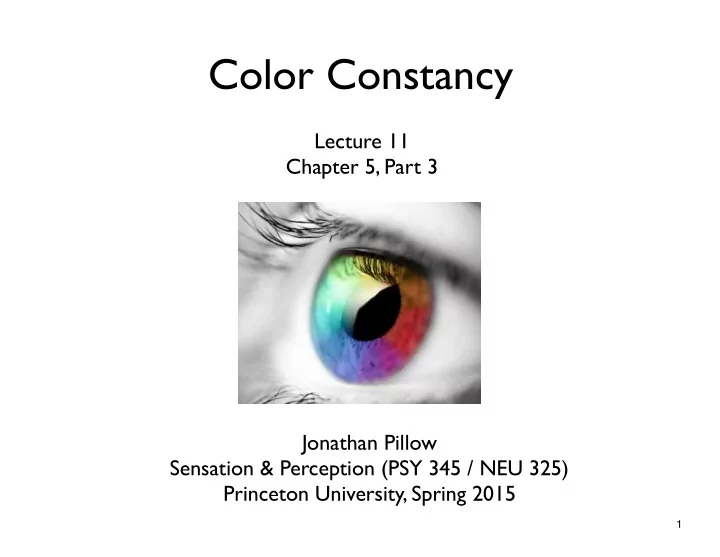

Color Constancy Lecture 11 Chapter 5, Part 3 Jonathan Pillow Sensation & Perception (PSY 345 / NEU 325) Princeton University, Spring 2015 1
Color Constancy The visual system uses a variety of tricks to make sure things look the same color, regardless of the illuminant (light source) • Color constancy - tendency of a surface to appear the same color under a wide range of illuminants • To achieve color constancy, we must discount the illuminant and determine the object’s surface properties 2
Illusion illustrating Color Constancy Same yellow in both patches Same gray around yellow in both patches (the effects of lighting/shadow can make colors look different that are actually the same!) 3
Exact same light coming to your eye from these two patches But the brain infers that less light is hitting this patch, due to shadow CONCLUSION: the lower patch must be reflecting a higher fraction of the incoming light (i.e., it’s brighter) 4
5
6
Beau Lotto 7
Beau Lotto 8
Color Constancy Beau Lotto 9
Color Constancy Beau Lotto 10
• Visual system tries to discount the effects of the illuminant: it cares about the properties of the surface, not the illuminant. ( on last slide: brain discounts the cone responses by taking into account information about much light is hitting different surfaces) • still unknown how the brain does this: believed to be in cortex (V1 and beyond). 11
• but : color-constancy is not perfect • possible to fool the visual system by: – using a light source with unusual spectrum (most light sources are broad-band; narrow-band lights will make things look very unusual) – showing an image with little spectral variation (e.g., a blank red wall). 12
or in rare cases we can fool 2/3 of the population (and sow division and hostility across the internet!) 13
So what’s going on? illuminant energy ? power spectrum × surface reflectance object of ? reflectance interest function energy light hitting = eye 400 wavelength 700 14
Possibility #1: dress in blueish light (or shadow) blueish energy light source × reflectance white stripe! energy = 400 wavelength 700 15
Possibility #2: dress in yellow light yellowish energy light source × reflectance blue stripe! energy = 400 wavelength 700 16
So: percept depends on inferences about the light source! 17
So: percept depends on inferences about the light source! Of course: we have no idea (so far) why people are making such radically different inferences about light 18
one possibility: where did you look first? Top 19
one possibility: where did you look first? Bottom 20
Color mixing • Mixing of lights (additive) vs Mixing of paints (subtractive) 21
Mixing of lights: • Additive color mixing • If light A and light B both arrive at the eye, the effects of those two lights add together • (that is, the power spectra add) 22
Georges Seurat’s painting La Parade (1888) • illustrates the effect of additive color mixture • reflected light from nearby dots adds together when blurred by the optics of the eye This is the same effect we get from a TV monitor with 3 kinds phosphors 23
Mixing of paints: • Subtractive color mixing • If pigment A and B mix, some of the light shining on the surface will be subtracted by A and some by B. Only the remainder contributes to the perception of color 24
Example of subtractive color mixture: “white”—broadband—light is passed through two filters This is the same result we’d get from mixing together yellow & blue paints. 25
color blindness • About 8% of male population, 0.5% of female population has some form of color vision deficiency: Color blindness • Mostly due to missing M or L cones (sex-linked; both cones coded on the X chromosome) 26
Types of color-blindness: dichromat - only 2 channels of color available (contrast with “trichromat” = 3 color channels). Three types, depending on missing cone: Frequency: M / F • Protanopia : absence of L-cones 2% / 0.02% • Deuteranopia : absence of M-cones 6% / 0.4% • Tritanopia : absence of S-cones 0.01% / 0.01% includes true dichromats and color-anomalous trichromats 27
28
29
30
Other types of color-blindness: • Monochromat: true “color-blindness”; world is black-and-white • cone monochromat - only have one cone type (vision is truly b/w) • rod monochromat - visual in b/w AND severely visually impaired in bright light 31
Rod monochromacy 32
normal trichromat protanope deuteranope tritanope monochromat scotopic light levels 33
Color Vision in Animals • most mammals (dogs, cats, horses): dichromats • old world primates (including us): trichromats • marine mammals: monochromats • bees: trichromats (but lack “L” cone; ultraviolet instead) • some birds, reptiles & amphibians: tetrachromats! 34
Color vision doesn’t work at low light levels! 35
Two Regimes of Light Sensitivity • Photopic : Light intensities that are bright enough to stimulate the cone receptors and bright enough to “saturate” the rod receptors • Sunlight and bright indoor lighting • Scotopic : Light intensities that are bright enough to stimulate the rod receptors but too dim to stimulate the cone receptors • Moonlight and extremely dim indoor lighting 36
Other (unexplained) color phenomenon: • watercolor illusion • neon color spreading • motion-induced color: Benham’s top 37
Watercolor illusion 38
Watercolor illusion 39
Watercolor illusion 40
Neon Color-Spreading 41
Neon Color-Spreading 42
Neon Color-Spreading 43
Neon Color-Spreading 44
Benham’s top: motion-induced color perception http://www.michaelbach.de/ot/col_benham/index.html • not well-understood; believed to arise from different color- opponent retinal ganglion cells having different temporal latencies. • the flickering pattern stimulates the different color channels differently (although this is admittedly a crude theory) 45
Summary • color constancy • photopic / scotopic light levels • additive / subtractive color mixing • color blindness 46
Recommend
More recommend